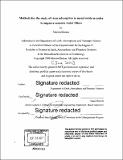| dc.contributor.advisor | Susan Murcott. | en_US |
| dc.contributor.author | Dumas, Marion (Marion M.) | en_US |
| dc.contributor.other | Massachusetts Institute of Technology. Department of Earth, Atmospheric, and Planetary Sciences. | en_US |
| dc.date.accessioned | 2018-03-12T19:30:38Z | |
| dc.date.available | 2018-03-12T19:30:38Z | |
| dc.date.copyright | 2006 | en_US |
| dc.date.issued | 2006 | en_US |
| dc.identifier.uri | http://hdl.handle.net/1721.1/114118 | |
| dc.description | Thesis: S.B., Massachusetts Institute of Technology, Department of Earth, Atmospheric, and Planetary Sciences, 2006. | en_US |
| dc.description | Cataloged from PDF version of thesis. Some pages in the original thesis contain text that is illegible. | en_US |
| dc.description | Includes bibliographical references (pages 91-93). | en_US |
| dc.description.abstract | As of 2002, 1.1 billion people lacked access to clean water, causing several million deahts each year from highly-infectious enteric diseases. It has been recognized that an appropriate way of addressing this problem may be to enhance the effectiveness and the usage of house-hold water treatment and storage (HWTS) systems. Ceramic filters are examples of HWTS systems. Ceramic filters decrease the concentration of bacteria by pore size filtration but are not able to filter the nanometer-size viruses. It is proposed that adding an adequate amount of metal oxides to the clay before firing the filters would allow the ceramic to adsorb the viruses present in the water. This thesis takes two steps towards evaluating this proposition. It demonstrates the microbiological methods needed to assess the presence of viruses in water and to carry out experiments with bacteriophages, used as model viruses. It also presents the theory necessary to understand, measure and model virus adsorption to surfaces. | en_US |
| dc.description.statementofresponsibility | by Marion Dumas. | en_US |
| dc.format.extent | 104 pages | en_US |
| dc.language.iso | eng | en_US |
| dc.publisher | Massachusetts Institute of Technology | en_US |
| dc.rights | MIT theses are protected by copyright. They may be viewed, downloaded, or printed from this source but further reproduction or distribution in any format is prohibited without written permission. | en_US |
| dc.rights.uri | http://dspace.mit.edu/handle/1721.1/7582 | en_US |
| dc.subject | Earth, Atmospheric, and Planetary Sciences. | en_US |
| dc.title | Methods for the study of virus adsorption to metal oxide in order to improve ceramic water filters | en_US |
| dc.type | Thesis | en_US |
| dc.description.degree | S.B. | en_US |
| dc.contributor.department | Massachusetts Institute of Technology. Department of Earth, Atmospheric, and Planetary Sciences | |
| dc.identifier.oclc | 1027706545 | en_US |
